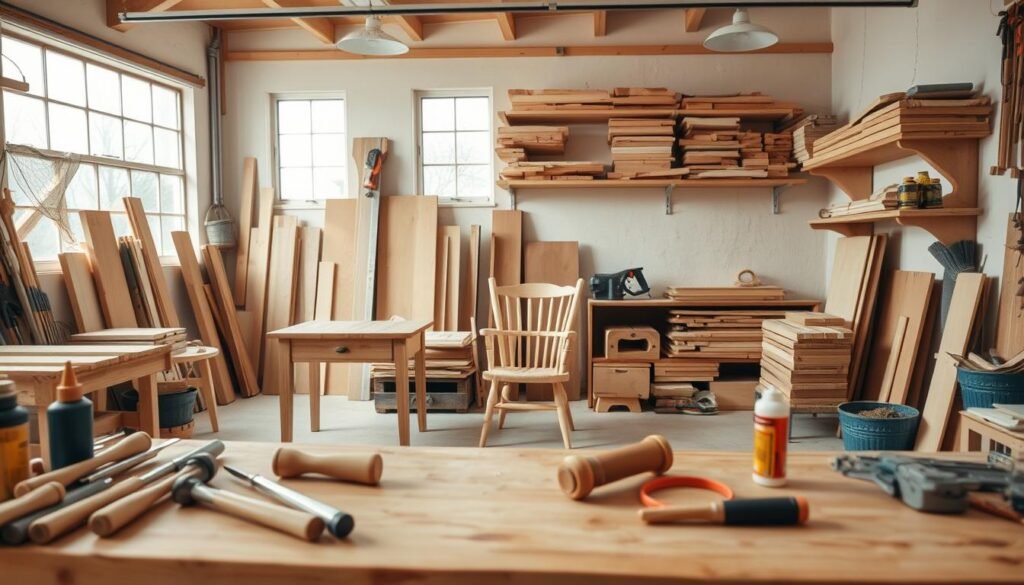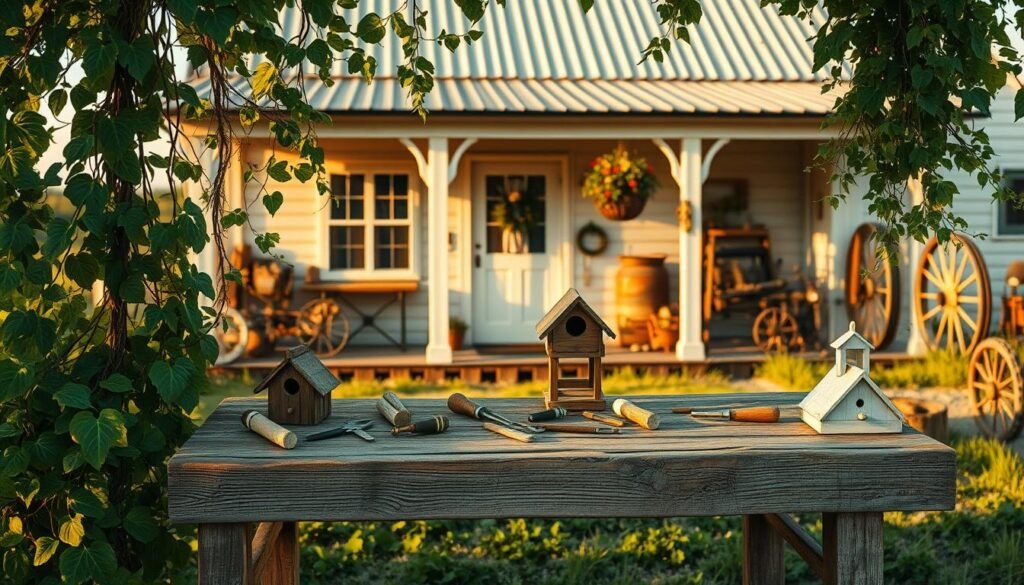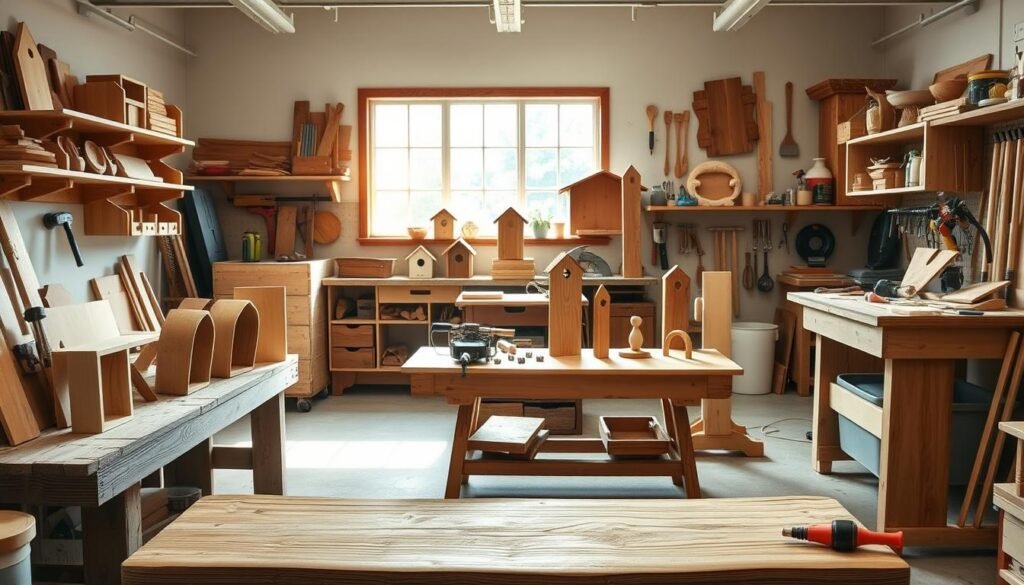Want a garden but think it’s too expensive? Building a raised garden bed with reclaimed wood is a budget-friendly, eco-friendly, and stylish option. This DIY project cuts down on waste and adds a personal flair to your yard.
Using recycled materials for gardening is becoming more popular. It’s a smart choice for the environment and can be very rewarding. Our guide will show you how to make a raised garden bed from reclaimed wood. It’s perfect for beginners in DIY gardening.
By following our simple DIY guide, you’ll not only make a useful garden bed. You’ll also help make gardening more sustainable.
The Benefits of Raised Garden Beds
Raised garden beds offer many advantages, like better drainage and soil quality. They let gardeners adjust the soil to fit their plants’ needs.
They also help with drainage. By raising the soil, water drains faster. This stops plants from getting waterlogged and rotting.
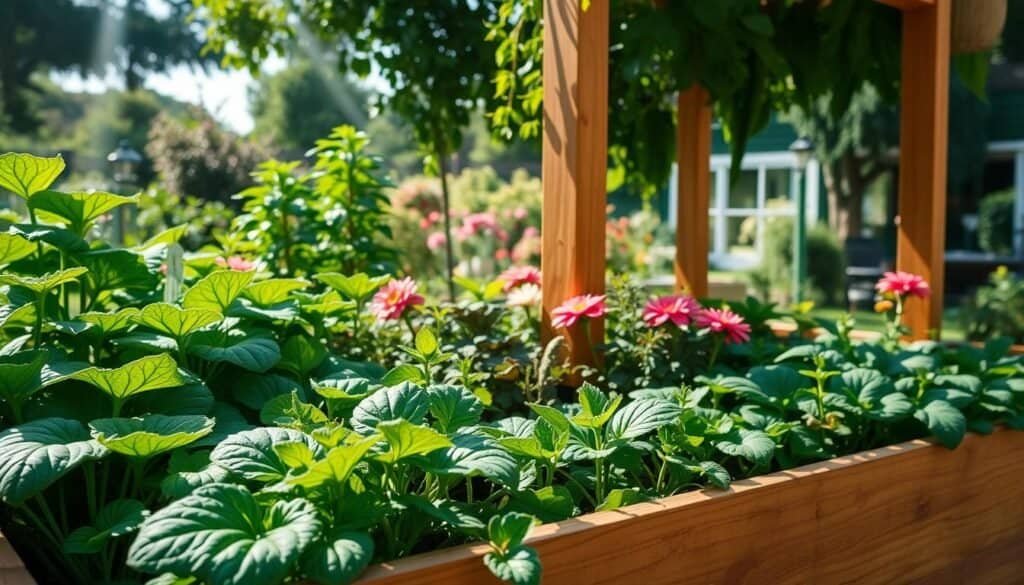
Another plus is how easy they are to access. The raised beds don’t require bending or kneeling. This is great for people with mobility issues.
In summary, raised garden beds help plants grow better and make gardening more fun. They improve soil, drainage, and accessibility. This makes them a top choice for gardeners at any level.
Why Choose Reclaimed Wood for Your Garden Bed
Using reclaimed wood for your garden bed is good for the environment and adds character. It comes from old buildings, fences, and more. This gives it a unique history and look that new wood can’t match.
Reclaimed wood is sustainable. It uses wood that’s already been cut down, saving forests. This reduces the harm caused by making new lumber.
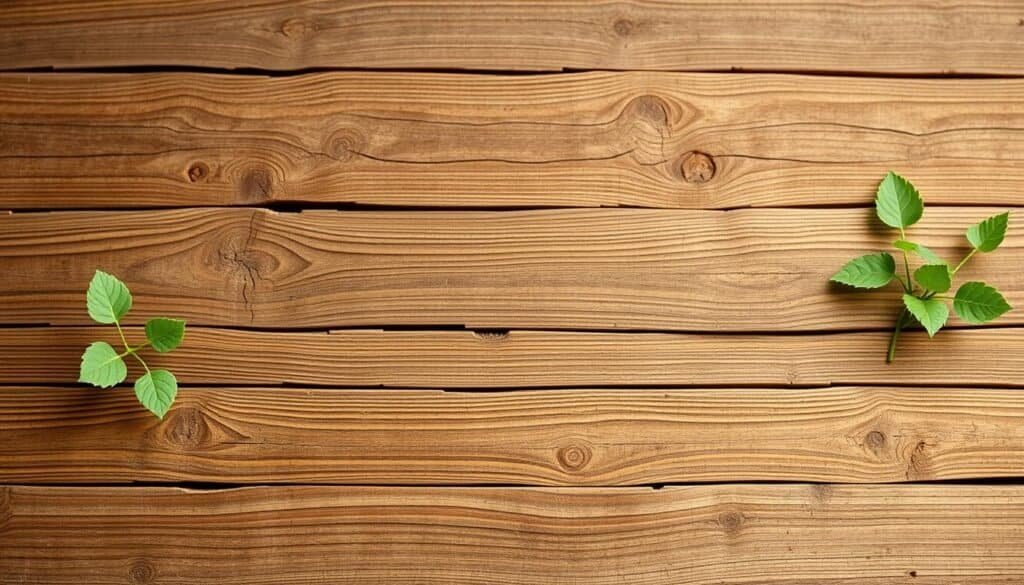
It also makes your garden bed look great. The weathered look and textures add depth and character. They contrast beautifully with your plants.
Plus, reclaimed wood is very durable. It’s been seasoned by years of weather, making it last longer. This means your garden bed needs less upkeep and won’t need to be replaced often.
Choosing reclaimed wood for your garden bed supports green gardening. It also creates a unique and beautiful feature that has its own story.
Finding and Selecting Reclaimed Wood
Reclaimed wood brings history and character to your garden. But finding the right pieces can be tough. To make your raised garden bed stand out, you need to look in different places for the perfect wood.
Start by checking local classifieds. People often list old materials from torn-down or fixed-up buildings there. You can also search online on Craigslist or local groups. Make sure to check the wood for damage or rot when buying from someone.
Local Classifieds and Habitat for Humanity ReStores
Habitat for Humanity ReStores are great for finding reclaimed wood. They sell donated building materials, like lumber, at low prices. You’ll not only get good wood but also help a good cause.
Also, think about visiting old barns or fences being taken down. These places often have quality, aged wood for garden beds. Just remember to ask permission before taking any materials.
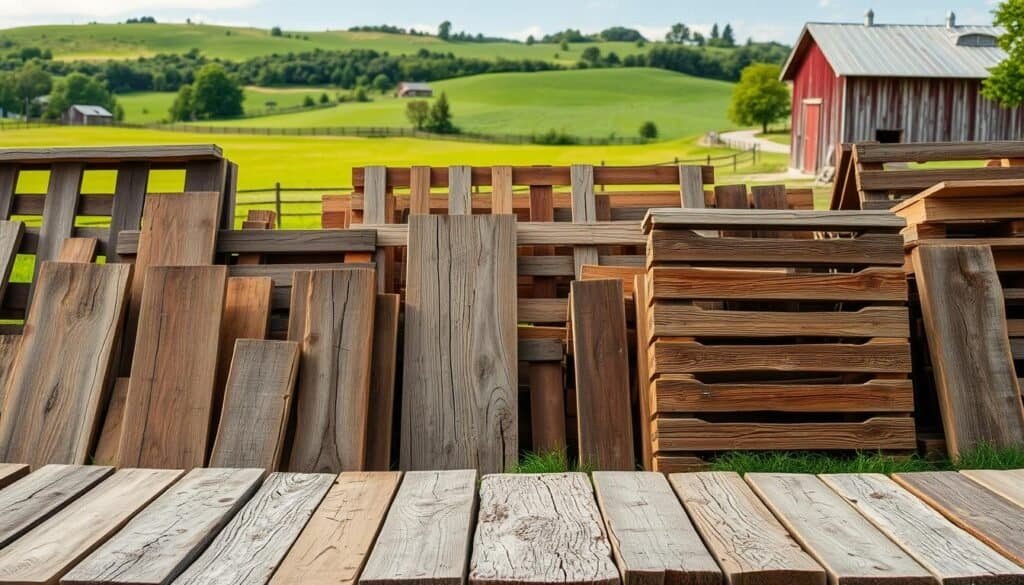
When picking reclaimed wood, look for sturdy pieces without big damage. Think about the wood type and how well it lasts outside. Choosing the right wood will make your raised garden bed beautiful and eco-friendly.
Safety Considerations When Working with Reclaimed Wood
When working with reclaimed wood for your garden bed, safety comes first. The wood might have hidden dangers like nails, splinters, and mold. These can hurt you or make you sick.
Before you start, check the wood carefully. Wear gloves and safety glasses to protect yourself from splinters and eye injuries.
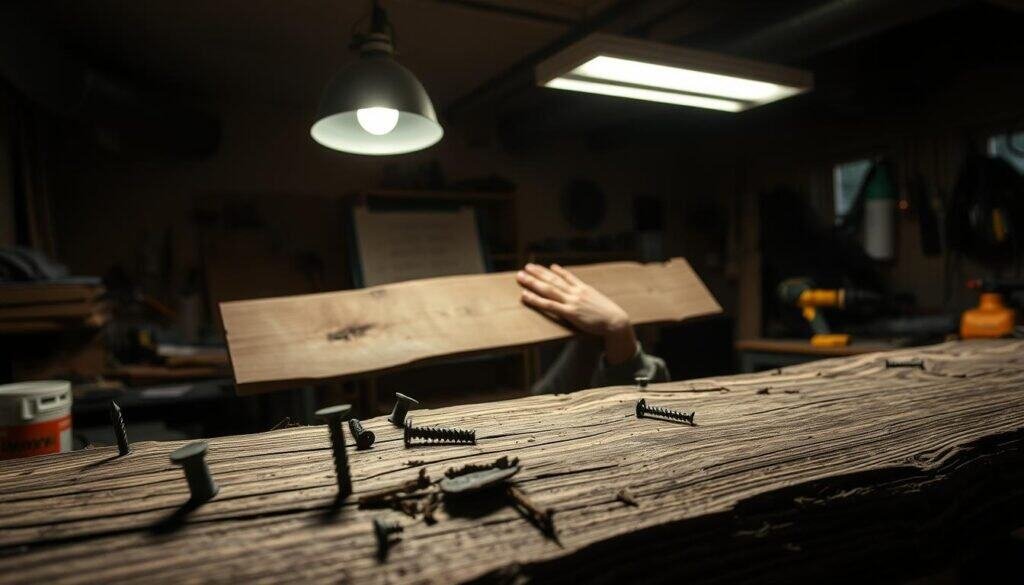
Also, watch out for nails and metal bits in the wood. A metal detector can spot these dangers. Make sure you have good air flow to avoid breathing in mold spores or dust.
By being careful, you can avoid the risks of reclaimed wood. This way, your DIY project will be safe and fun.
Essential Tools and Materials for Your Project
Having the right tools and materials is key to a successful raised garden bed project. Being well-prepared ensures a smooth construction process.
You’ll need a variety of tools to start. A saw is essential for cutting the reclaimed wood. A drill is also necessary for making holes for screws or nails. A hammer is needed for tapping screws or nails into place.
Other important tools include a tape measure for measuring, a square for aligning corners, and a level for ensuring the bed is even.
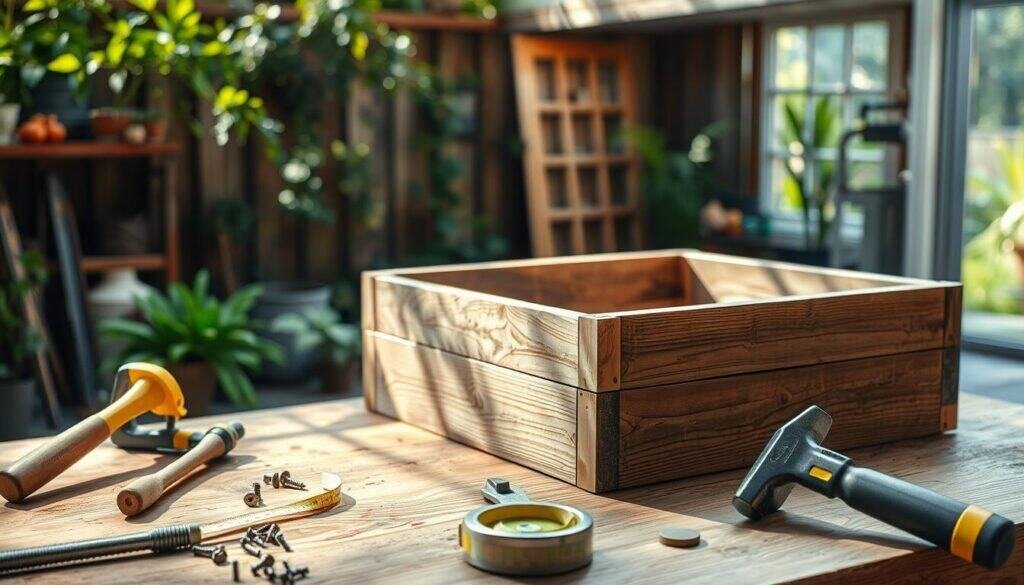
Reclaimed wood is the main material for your raised garden bed. You’ll also need screws or nails to assemble it. Depending on your design, landscape fabric might be added to prevent weeds.
Wood screws, wood glue, and wood finish can also improve your raised bed’s durability and look. Having all tools and materials ready before starting makes the construction process more efficient and fun. This way, you can focus on designing the layout and choosing plants for your garden.
Planning Your Raised Garden Bed Design
Before you start building your raised garden bed, planning is key. You need to think about the space and the plants you want to grow. This planning ensures your garden bed meets your needs.
The size and layout of your raised garden bed are very important. Measure the space where you’ll put the bed. Make sure there’s enough room for your plants to grow and for easy access.
When choosing a size, think about the materials you’ll use. For example, reclaimed wood can make beds of different sizes. You can have small, simple beds or big, detailed ones.
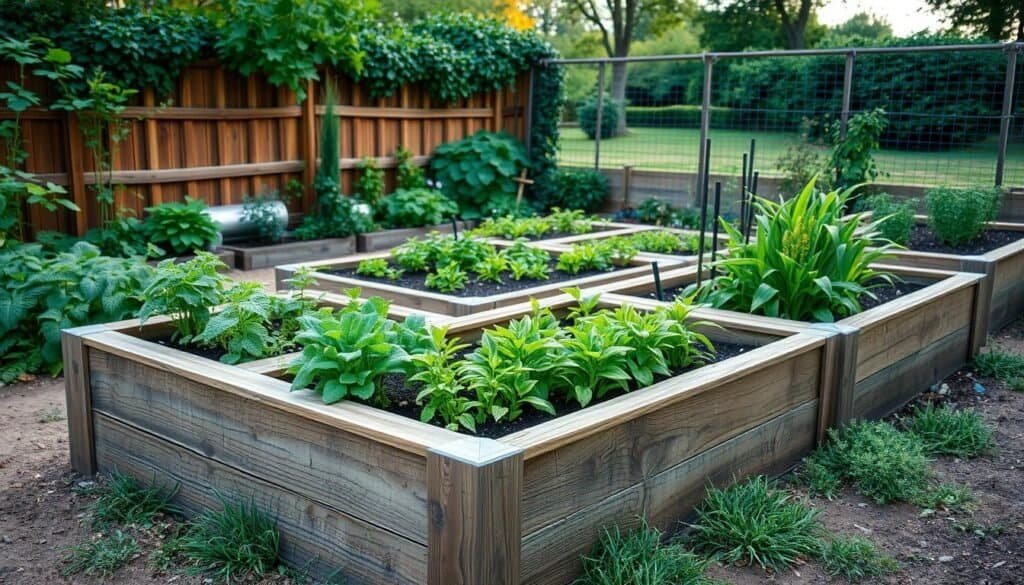
The shape of your raised garden bed can also change based on your preferences and space. While rectangular beds are common, you can try square, circular, or hexagonal shapes. This adds interest to your garden.
Don’t forget about the height of your raised garden bed. Taller beds are easier on your back but need more materials. Make sure your design is practical and fits your gardening goals.
By planning well, you can make a beautiful and useful garden space. It will meet all your gardening needs.
Preparing Your Reclaimed Wood
Preparing reclaimed wood is key to making a durable raised garden bed. Before you start, clean and prepare the wood. This makes sure it’s free from debris and damage.
First, remove any nails, screws, or metal objects. Use a hammer, pliers, or a metal detector to find hidden objects. After removing metal, check the wood for damage or rot.
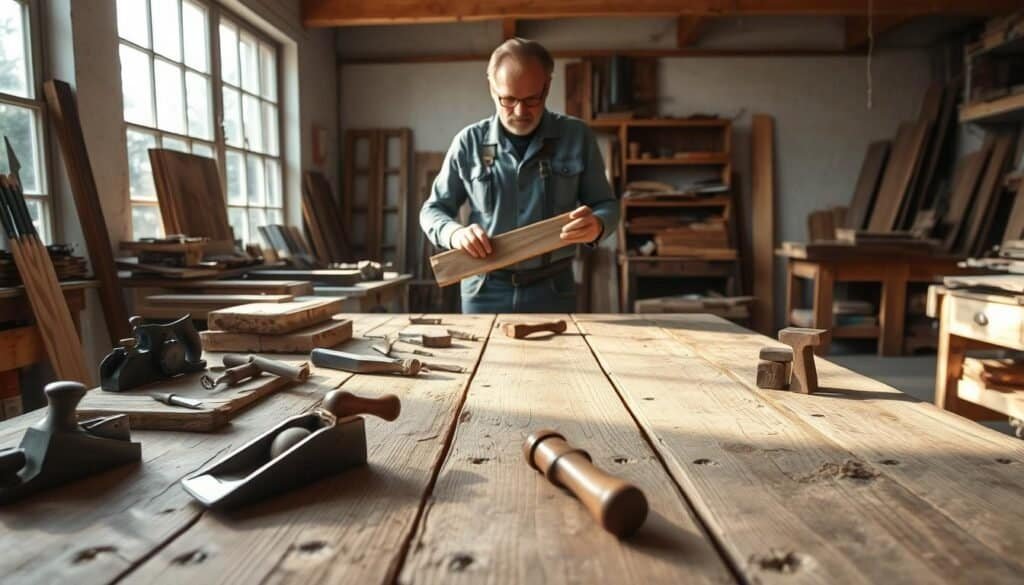
Next, clean the wood well to get rid of dirt, grime, or old paint. Use a wire brush or scrub brush for tough dirt. Let the wood dry completely before you go on.
When the wood is dry, cut it to the right size for your bed. Use a saw or circular saw for precise cuts. Make sure cuts are straight and smooth to avoid splinters or rough edges.
By following these steps, your reclaimed wood will be ready for a sturdy and lasting raised garden bed.
How to Build a Raised Garden Bed with Reclaimed Wood (Easy DIY Guide)
Building a raised garden bed with reclaimed wood is a fun DIY project. It can make your outdoor space look better. This guide will help you build a garden bed that looks good and works well.
Start by building the frame of your raised garden bed. Cut the reclaimed wood into the right lengths for your design. Use a saw for accurate cuts and sand the edges to make them smooth.
Then, attach the corners of your frame with wood screws or nails. Make sure the corners are square and the frame is level. This will give your garden bed a solid base.
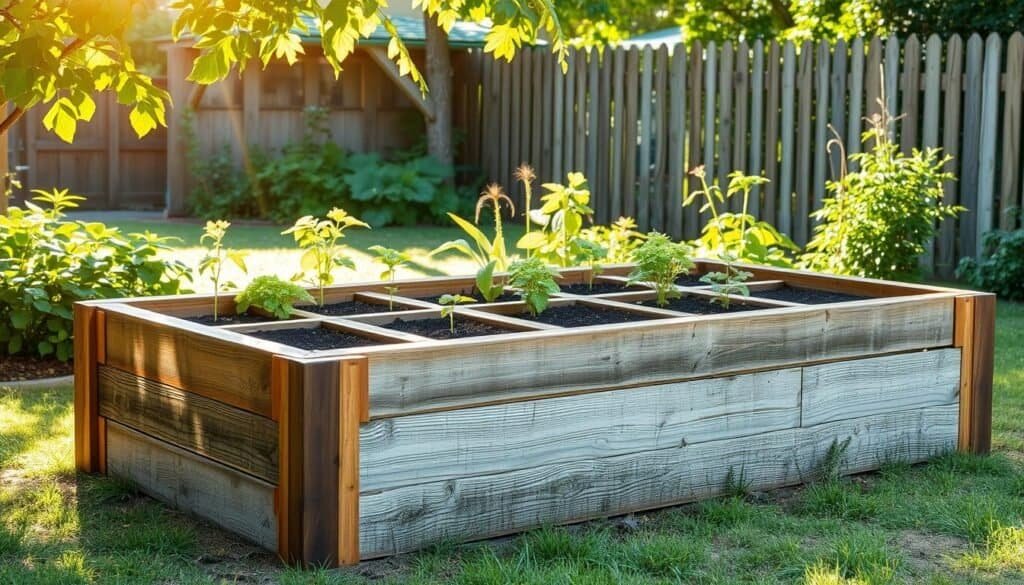
Once the frame is built, prepare the spot for your raised bed. Remove any debris and level the ground. Place your frame on the site and check that it’s stable.
Lastly, fill your raised garden bed with a mix of soil and compost. The reclaimed wood will add charm to your garden. The raised bed will also help your plants get the air and water they need.
By following these steps, you can make a beautiful and useful raised garden bed. It will improve your gardening experience.
Creating a Durable Base for Your Garden Bed
A strong foundation is key for a healthy raised garden bed. To achieve this, you need a durable base that can handle different weather and pests.
Start by lining the bottom of your garden bed with hardware cloth. This mesh material is made from metal and keeps pests like moles, gophers, and rabbits out. It’s stronger than chicken wire and can stop determined pests.
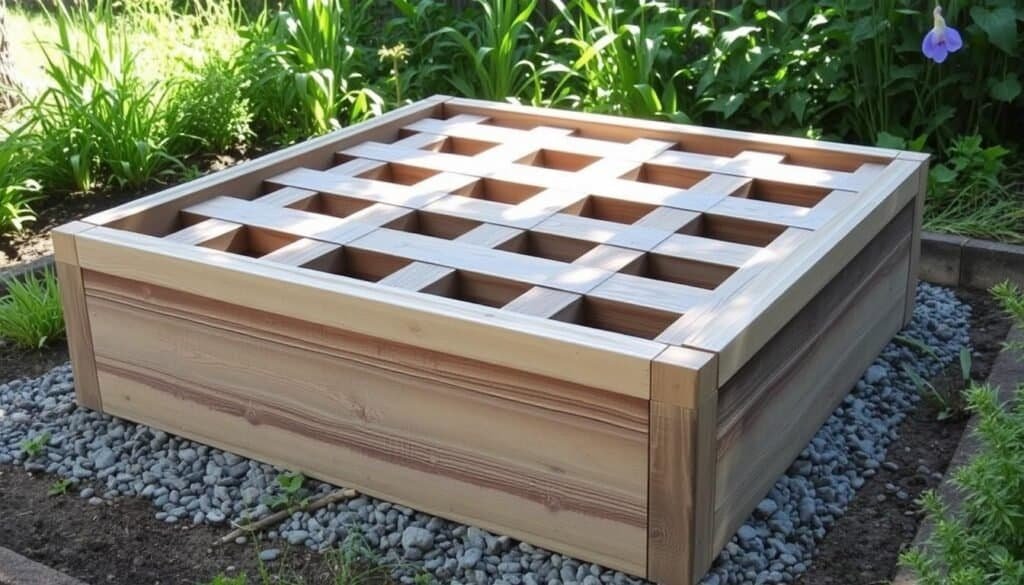
Adding hardware cloth to your garden bed helps prevent pests. This protects your plants and makes your garden bed last longer. A solid base also helps with drainage, avoiding waterlogged soil and its problems.
In short, a durable base is vital for a successful raised garden bed. Using materials like hardware cloth helps prevent pest damage and keeps your garden healthy for years.
Enhancing Your Raised Bed with Additional Features
Adding extra features to your raised garden bed can make gardening easier. Features like irrigation systems and trellises make your garden more functional and productive.
An irrigation system is a great addition. It ensures your plants get water consistently, reducing the need for constant watering. You can choose from drip irrigation or soaker hoses, depending on your garden’s needs.
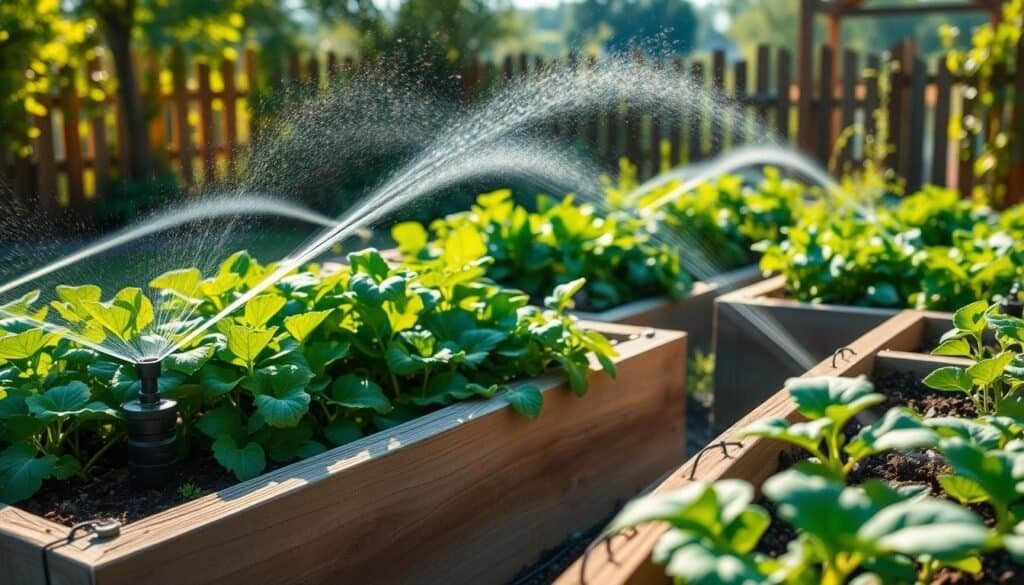
Trellises are another great feature. They support climbing plants like peas, beans, and cucumbers. This allows them to grow upwards, maximizing your space. You can pick from wood, metal, or plastic trellises, based on your garden’s style.
Other features to consider include irrigation timers and garden covers. Timers automate watering, and covers protect plants from pests and weather. These additions make your garden more sustainable and easy to maintain.
When planning these features, think about your plants’ needs and your garden’s design. This way, you’ll create a garden that’s both beautiful and productive.
Filling Your Raised Garden Bed
Filling your raised garden bed with the right soil mix is key for healthy plants. The mix affects drainage, nutrient availability, and growing conditions. It’s essential for your plants’ health.
A good mix balances moisture retention and drainage. This balance prevents waterlogged soil. Waterlogged soil can cause root rot and other issues.
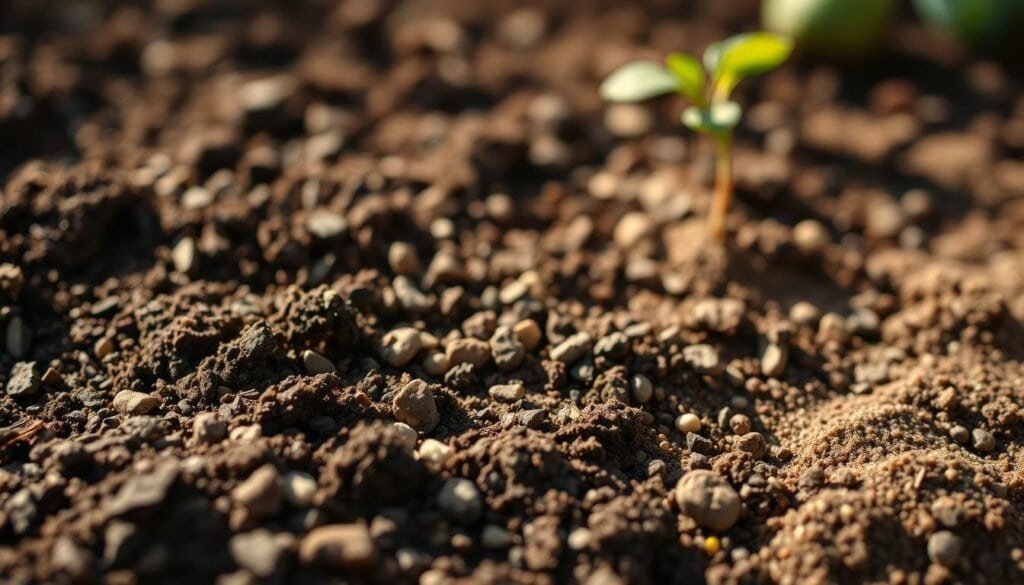
For nutrient-rich soil, add compost, well-rotted manure, or peat moss. These improve soil structure and support root growth. They also provide essential nutrients.
The pH level of your soil is also important. Most plants do best in slightly acidic to neutral soil, with a pH of 6.0 to 7.0. Testing and adjusting the pH can boost plant growth.
Choosing and preparing your soil mix carefully creates a great growing space. This effort leads to healthier plants and a better harvest.
Planting Your New Raised Garden Bed
Planting your raised garden bed is the next exciting step in your gardening journey. Your bed is built and ready. Now, you can choose the right plants to thrive in their new home.
The choice of plants depends on your local climate, soil type, and sunlight. For full sun, grow vegetables like tomatoes, peppers, and cucumbers. If it’s partially shaded, herbs like mint, parsley, or flowers that love shade are better.
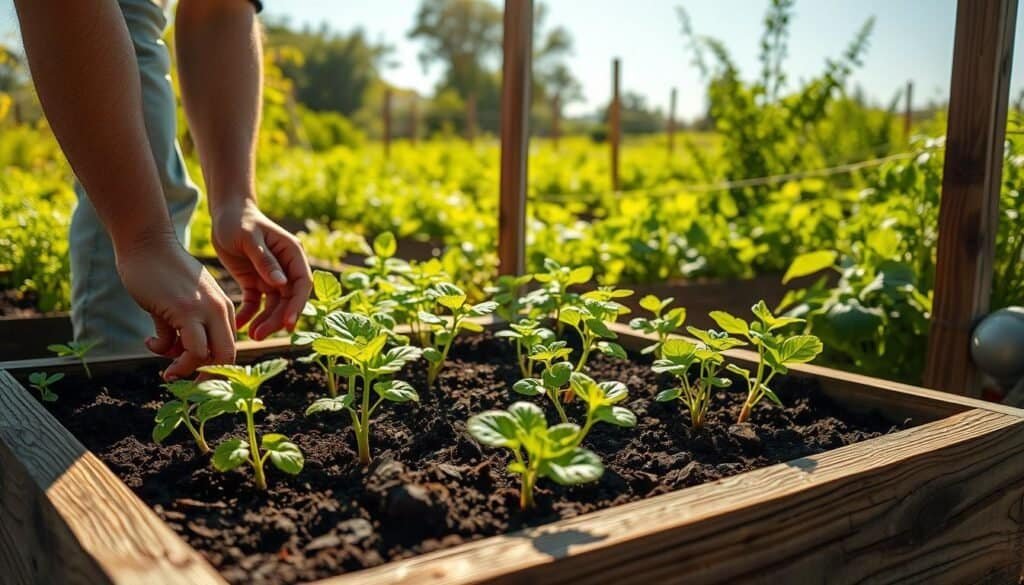
Start by preparing your soil. Make sure it’s well-mixed and has the right consistency for planting. Then, follow the spacing instructions for each plant. Overcrowding can cause competition for nutrients and diseases.
For a diverse and resilient garden, mix vegetables, herbs, and flowers. This adds beauty and helps deter pests. For example, marigolds with tomatoes can fight nematodes.
Water your plants well after planting. Keep the soil moist during their first growing season. With care, your raised garden bed will flourish, giving you fresh produce and beauty all season.
Seasonal Care and Maintenance
To keep your raised garden bed in top shape, regular care is key. This includes tasks that keep your garden healthy and productive.
Watering is a big part of seasonal care. How often you water depends on the weather and your plants. In hot summers, you might need to water more. But in cooler months, you can water less.
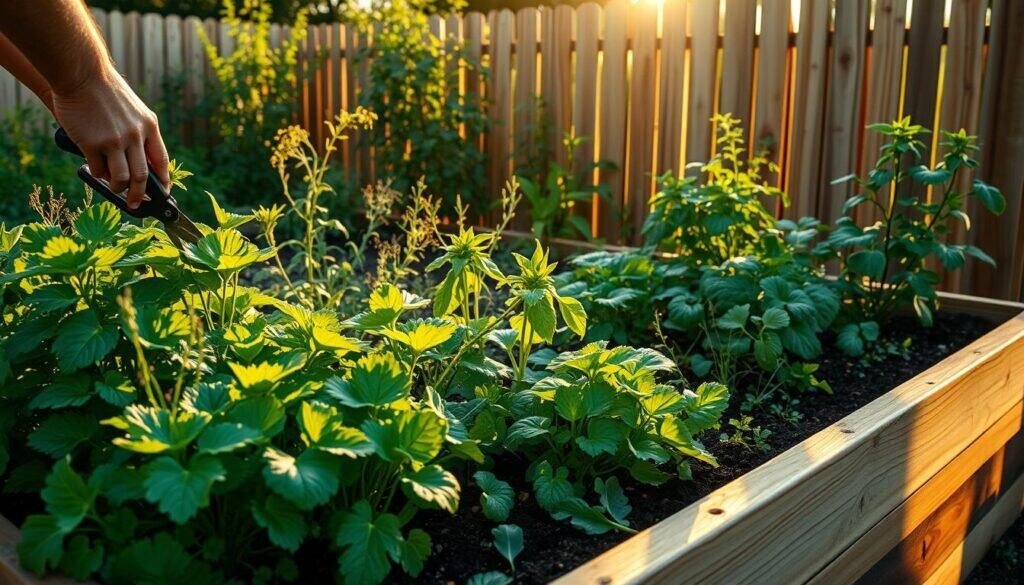
Fertilizing is also important. Use organic fertilizers like compost or manure to feed your plants. Pruning your plants regularly helps them grow well and stay disease-free.
Also, check your garden often for pests or diseases. Acting fast can stop disease from spreading and reduce damage.
By following these tips, your raised garden bed will flourish all year. Regular care and maintenance keep your plants healthy and make your garden look great.
Troubleshooting Common Issues
Troubleshooting is key for gardeners, mainly for keeping raised garden beds healthy. Even with reclaimed wood, you might face pests, diseases, and nutrient issues.
Pests like aphids, slugs, and snails can be a big problem. To fight them, try natural methods. This includes introducing beneficial insects or using organic pesticides.
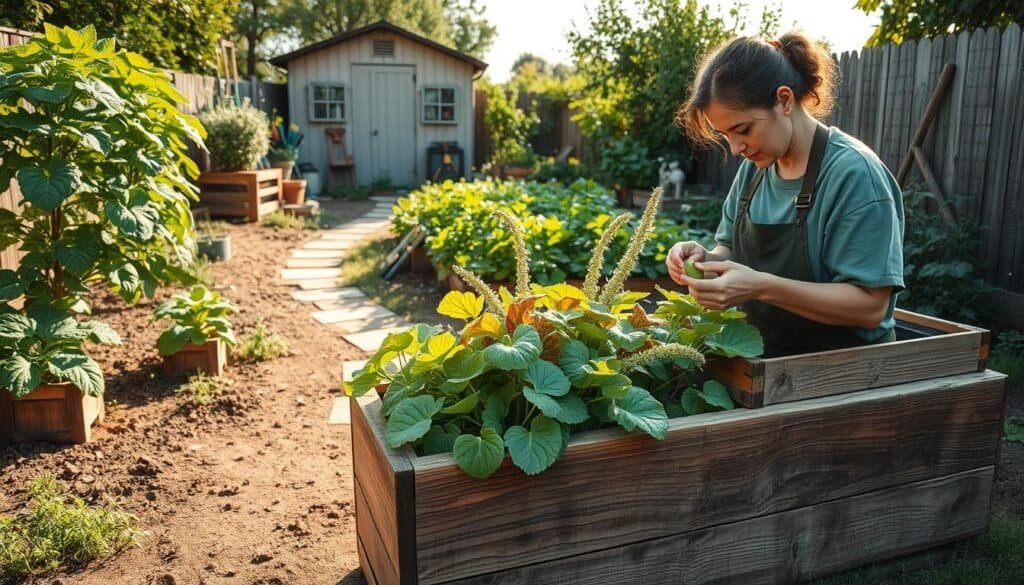
Diseases can harm your plants too. They might come from bad air, too much water, or dirty soil. Keep your garden clean, space plants well, and choose disease-resistant types.
Nutrient shortages can slow down plant growth. Test your soil regularly to find out what’s missing. Adding compost can also boost soil health and fertility.
Knowing how to fix common problems helps keep your garden healthy. Watch your garden closely and act fast to stop small issues from getting worse.
Conclusion
Building a raised garden bed with reclaimed wood is a rewarding DIY project. You’ve learned how to make a sturdy and beautiful garden bed. It will make your outdoor space even better.
Raised garden beds are known for their benefits. Using reclaimed wood adds an eco-friendly touch. It reduces waste and gives your garden a special look.
As you enjoy your garden, remember that DIY gardening is all about trying new things and learning. Your raised garden bed needs care and upkeep. But the joy and fresh produce it brings are worth it.
In short, making a raised garden bed with reclaimed wood is a great choice. It brings many benefits and the joy of creating something yourself. This project will add happiness and fresh food to your life.

